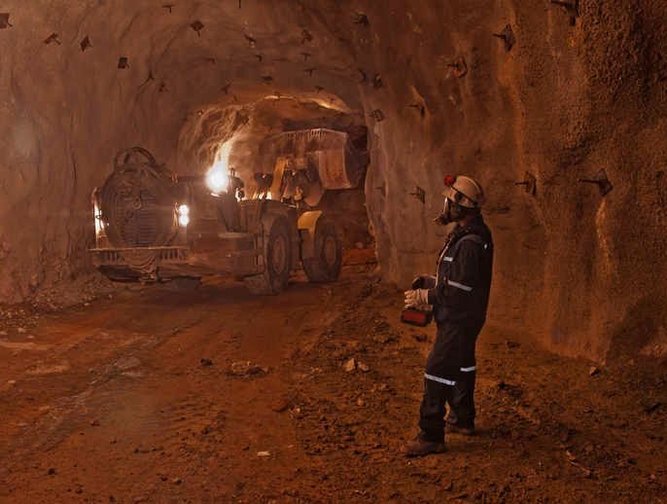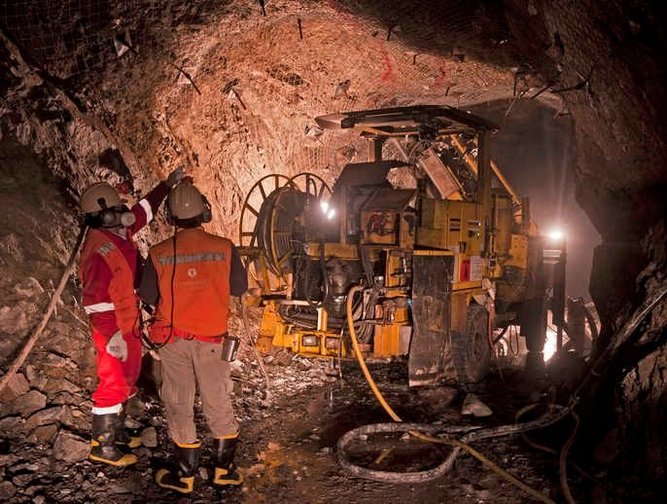Yamana Gold digitises the gold sourcing world through blockchain technology
The world of mining is changing. Historically known as an industry lagging behind when it comes to the implementation and deployment of technology, over the course of the last five years the mining conversation has turned towards innovation.
One of the biggest conversations in mining, throughout history, surrounds the sourcing and supply of raw material, and now a number of companies are investing into technology solutions in order to track, trace and ethically manage its mineral supply chain.
One such company that looks for innovative solutions to mining challenges is Canadian gold producer Yamana Gold. The company’s vision states its intentions clearly – to mine precious metals profitably and responsibly.
It is this focus on responsible mining that has driven the company to partner with Emergent Technology Holdings to implement an innovative blockchain solution for the responsible sourcing of gold, making it the first in the industry to partner with the American firm.
“We are not the only ones working on supply chain solutions in the gold sector, but in our view, this solution, in particular, is unique; it adds significant value to both us, as industry participants, and more so to people in communities where we mine and buyers, consumers and investors of precious metals. On the one hand, it leverages blockchain technology to execute supply chain contracts between miners, refiners, logistics providers and buyers in what has historically been a very manual and inefficient process with data recorded across disparate systems and several industry participants. This solution is certainly an improvement. And, perhaps more importantly, it leverages this technology to track and trace the provenance of gold from mine to vault, providing virtually absolute assurance that the gold produced through this supply chain solution is responsible gold, complying with the strictest due diligence standards including the World Gold Counsel’s Conflict-Free Gold Standard. There’s a market for that. We are starting to see pent up demand for responsibly-sourced gold from jewellers, electronics manufacturers and even fund managers who have long been driving and promoting socially conscious and responsible agendas. With Emergent, and other supply-chain participants, we have developed an ecosystem to essentially guarantee that production flowing through it is 100% responsible gold. Now, we and Emergent, hope to populate this ecosystem with as many supply chain participants as possible” says Tony Cina, Senior Vice President, Business Administration, Yamana Gold. “This is an industry-wide solution. It is not exclusive to Yamana. If a participant contributes to responsibly-produced gold, then we encourage their participation.”
“So ideally that means every miner, every refiner, every logistics partner and everyone in the entire precious metals supply chain joins the ecosystem; and Emergent is talking to all the major market players aiming to secure their participation. It is in everyone’s best interest to have one ecosystem that buyers, consumers and investors can depend and rely on. This is a unique opportunity for the gold sector to band together to further contribute to the improvement of social and humanitarian conditions in remote areas”
Yamana Gold will utilise Emergent’s Responsible Gold Platform, the only permissioned blockchain that tracks responsibly sourced gold from its origin through to the end buyer. Along with supply chain partners, Yamana Gold will use a secure mobile network that scans smart chips in tamper-proof seals to record transfers of custody and other data on the Responsible Gold blockchain.
“We had a unique interest in the supply chain element of gold production,” Cina says. “We saw the potential to employ an innovative solution to an industry challenge and we recognized the benefit in developing that solution through collaboration.”
Yamana Gold first worked with Emergent Technology back in 2016, and this partnership is part of a larger strategy whereby the company has sought out new ways of implementing technology and innovation to refine its operations.
As technology continues to shape the world of tomorrow, Joe AbiDaoud, Vice President, IT at Yamana Gold, understands that the very nature in which a mining company must operate is changing.
“It’s no secret that every company in the world is becoming a technology company,” he says. “We work in a very cyclical industry that will forever go through ups and downs, and what we’ve begun to see in recent years is companies understanding that in order to stay competitive, they need to start doing things differently.”
And doing things differently is exactly what Yamana Gold has been doing as it undergoes a significant technology transformation.
But, as AbiDaoud notes, innovation and technology not only change the practical, physical element of mining, such as the automation of equipment, but innovation is almost driving the strategic thinking and direction of organisations.
“The industry as a whole has been undergoing a significant transformation for quite some time,” says AbiDaoud, “albeit at its own pace and perhaps a little slower than others. This comes down to the cyclical nature. Gold prices plummeted in 2013, and it forced everyone to rethink our operating model.
“Technology is one component of that, it’s not the only component but over time it has become more and more integral to the way in which Yamana Gold achieves success and will continue to deliver value.”
AbiDaoud entered Yamana Gold in 2017 with a core mission to drive innovation and seek out opportunities to leverage technologies to provide value and to support the overall vision of the company, which is to mine precious metals profitably and responsibly.
For AbiDaoud, three core pillars define innovation: people, process, and technology. When organisations think of innovation, they often focus largely on the technology aspect, while AbiDaoud believes the people and the processes are more important.
“For some they seem to fail to recognise the important impact and role that people and process have to play in helping your organisation innovate,” he says.
“Technology can’t move forward if the people and processes don’t move forward with it, so it becomes fundamentally about changing the way we work and the way we operate. Technology in the end is just a tool to do that.”
The people element to innovation should not be understated, especially in an industry that has largely operated in the same manner for decades. Technological innovation breeds a cultural change, but as any transformation has shown, cultural change is no walk in the park.
Part of that challenge is communication. Yamana Gold approaches this a little differently.
“We actually don’t have a technology conversation,” says AbiDaoud. “When you’re speaking about innovation, or doing things differently, we don’t even talk about technology. It’s about talking about business outcomes in a language that’s understandable and relevant to the end user’s business. That’s how you get a much more engaged partner at the end of the day.”
As VP of IT, AbiDaoud has lived and breathed technology throughout his entire career and so it may be easier for him to say that due to his extensive experience. But it is a feeling shared by Cina, as he sees Yamana Gold’s approach to technology centred much more around efficiency and effectivity, rather than seeking out problems.
“We work with our operations and exploration teams to better understand what challenges they face and together consider whether there are operational or other technologies that could be deployed to resolve those challenges. Our approach is targeted. We do not introduce solutions and then look for problems for which to solve. The solutions are very specific. They either solve a problem or create an opportunity” says Cina. “That’s why we try not to have discussions focused entirely on technology. It’s about how we can become more efficient; how can we produce more ounces both profitably and ethically. It’s about working with our strategic partners and seeking out areas of opportunity, to which we then work collaboratively to find a solution.”
See also:
- Mondelēz International embraces new technologies in order to cater to the diverse tastes of Asia
- Pemex, technology and the 2017-2021 Business Plan: An interview with CIO Rodrigo Becerra Mizuno
- How Yatra Online is redefining the travel sector with groundbreaking technologies
The partnership with Emergent Technology and the implementation of the company’s Responsible Gold blockchain platform is but one shining example of Yamana Gold’s approach to technology, but it is not the only one.
Yamana Gold has invested in Emergent’s “G-Coin”, a digital token backed by physical gold sourced from the Responsible Gold supply chain platform.
“The conversation started a few years ago from a group consisting of technology experts, fintechs legal experts and gold market participants to look at the possibility of digitising gold,” says Cina. “We were invited as the only gold supply-chain representative.”
“While initially we were not clear on where the discussion would lead, we quickly caught on to the concept of a digital gold currency that was backed, and had its value supported by, conflict-free gold.” This was a novel concept a couple of years ago. Today it’s a lot more real. And tomorrow even more so.
G-Coin, first and foremost, is not a cryptocurrency, it is digital gold. It provides a digital certificate of ownership to physical gold stored in a secure vault, opening access to responsible gold as an investment, wealth transfer vehicle and payment mechanism.
As AbiDaoud admits, it’s not an answer to a business problem, it’s an opportunity to open up efficiency and profitability, all the while remaining committed to responsible, ethical gold sourcing.
Cina adds: “It is not the only digital token of gold in the world, but what makes it different is that it is more than just a digital store of value. It can actually be used as a medium of exchange to settle transactions or transfer value. That’s where it’s unique. I don’t know of anyone else that’s using responsible gold to back a viable digital currency.
“Tracing gold from the mine site right into a vault, and then ultimately to a currency that you can spend or transfer to individuals and businesses across global markets - that, for us is innovative.” Cina went on to say that “since the beginning of time, gold has been a store of value. With blockchain technology, gold can now be digitized; you can own it in your digital wallet and no longer have to hold physical gold. But what does the digitization of gold really solve if all you have done is alter the form in which wealth is stored?” Cina argues, “not much. But when you introduce the ability to spend and transfer gold as if it were cash, instantly, with zero transaction fees and in the smallest of denominations - that is a real solution. That’s innovative”
Cina believes that the case for G-Coin is especially feasible in emerging markets, where currencies are more sensitive to inflation and currency devaluation and in some cases subject to currency controls. “The introduction of a gold-backed digital currency becomes extremely appealing to individuals and businesses in those markets”. Users will now have the ability to convert their local currency into the G-coin and protect their wealth and purchasing power.
Through the Responsible Gold platform, and the advent of G-Coin, the mining landscape is well and truly on the cusp of great change. The demand for conflict-free gold has already begun to surge over recent years, with more and more participants looking to change the way in which they purchase and acquire gold.
But what does the future truly hold for the ethical sourcing of gold?
Cina feels that, in actual fact, we could see a whole new gold asset class.
“In 5-10 years, or perhaps less, as demand for responsible gold continues to increase, responsible-gold emanating from this ecosystem may become a new and distinct asset class, demanding a premium to gold otherwise produced. This bodes well for the sector, its participants and for the people in areas where we mine precious metals.” This is why we got involved: good for gold and good for society – profitably and responsibly.”
Yamana Gold started this journey of digital transformation in 2016, but with technological innovation there is never truly an end to that journey. The official launch of G-coin is targeted for the third quarter of 2018, with the back-end technology already in place, but where does Yamana Gold go from here?
“With everything in place with regards to that launch date, the goal for Emergent is to introduce and integrate G-Coin into payment walls and wallets in those emerging markets,” says Cina. “Emergent expects to process approximately $2 billion in transactions and payments in these markets over the next year and are looking to have G-Coin become a widespread alternative to traditional payment methods, ultimately pushing gold to become the most liquid asset in the world.”
For AbiDaoud, the future is one of possibility and collaboration.
“There is great opportunity for us as an industry to become much more collaborative and unified in our approach to innovation,” says AbiDaoud. “What I’d like to see is an ecosystem that all industry participants are a part of, with real benefits to everyone. That would be a tremendous accomplishment for the mining industry.”




